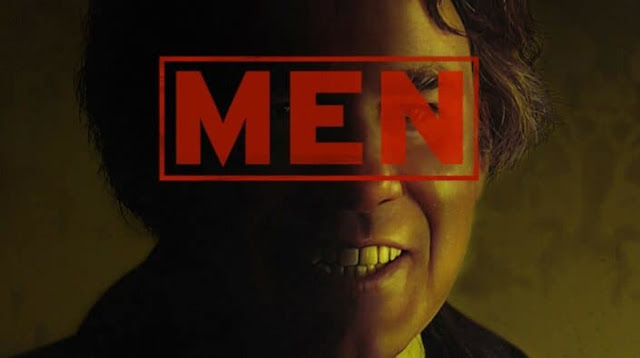The Mutating Male Monsters of Men (2022)
In spite of their reputation for jump scares, excessive gore and characters who routinely make dumb decisions, horror movies can be just as topical and informed as any other genre of film. However, like other film genres, how a horror movie goes about being topical can determine how well it can provide engaging, thought-provoking commentary about a topic. If the film devotes too much of its dialog to overtly address a particular issue, audiences might find the film to be too pedantic to be entertaining. On the other hand, a film may be better off addressing a topic through visuals and symbols that leave themselves open to interpretation but are nevertheless focused on a particular idea. Such is the case with Men, a 2022 horror film written and directed by Alex Garland.
The premise of Men is simple. Harper (Jessie Buckley) rents a country house in rural England for a few weeks to recover from her recently ended marriage. Her respite is soon interrupted by a series of increasingly strange and disturbing events, starting with a naked homeless man (Rory Kinnear) who tries to force his way into the house. Harper soon finds herself confronting a dangerous, inexplicable supernatural presence and is forced to acknowledge that her marriage isn't as finished as she wants it to be.
If I had to explain in a nutshell what type of horror film Men is, I would say that it is a ghost story with a heavy dose of body horror. It may seem odd to mix together something as enigmatic as ghosts with something as unmistakable as body horror, but that's what Garland does and it works to great effect. Obviously, he took his special effects experience from Ex Machina (2014) and Annihilation (2018) and builds upon it to approach the subjects of gender roles, relationships, and misogyny in Men.
I cannot write about Men without emphasizing how visual it is. Even though cinema is an inherently visual medium, I think it's quite rare to see a film by a director who actually understands that and places as much an emphasis on the usage of color, lighting, film speed and shot compostion as he does on dialog and acting. According to IMDb, there is a 17-minute sequence in this film (which has the runtime of 100 minutes) where no dialog is spoken; from what I saw, the "dialog" in that sequence was provided by what was on the screen itself. What Garland does is he surrounds his actors with sets, scenery and effects that enhance the story they are collectively telling, letting the visuals express ideas and emotions in ways that might feel awkward or get lost altogether in the spoken word. Indeed, for as many effects as there are in this film, the most haunting for me was a shot done in slow motion--one of the most effective usages of slow motion I can recall.
To say that Men is dreamlike in its visuals is an understatement. While I'm sure people who are more well-versed than I am in history, literature and art can spot the many details that I missed, I could appreciate how skillfully Garland uses special effects in both explicit and implicit ways. In particular, Kinnear plays several different characters in the movie: He wears different makeup, costumes and hair pieces to play some of the characters, and his face is attached to the heads of other actors via CG effects to play other characters. The end result of these alternating techniques is very unnerving because I couldn't always tell who or what I was looking at on the screen.
Then there's the supernatural monster itself, which assumes many forms. I couldn't tell if it is one being that wore many faces or multiple beings that originated from a single source; likewise, I couldn't tell if Harper is being haunted by someone from her past or if the supernatural being attacking her was just reflecting her trauma back to her as a form of torment. This ambiguity may sound frustrating, but the monster presents itself in a series of forms that are so vivid and shocking that it never stops compelling your attention. In fact, it is this fluidity of form that allows Garland to elaborate on the pervasive, burdensome and sometimes traumatic presence that sexism and misogyny have on women. It's a very ambitious (if not repulsive) usage of creature effects; Last year's Smile attempted to depict something similar about confronting trauma, but it wasn't nearly as effective as what Garland accomplishes in Men.
(An observation: When interviewed about the chestburster scene in Alien, screenwriter Dan O'Bannon said that he wrote it to make men squirm. As Daniel Kurland wrote in a ScreenRant article titled "Alien’s Chestburster Scene Real Meaning Explained" in 2019, "Dan O'Bannon specifically wrote this scene with the male's fear of penetration in mind and wanted the scene to operate as a payback of sorts for all of the times horror films have subjected weak women to male predatory monsters. His goal was to reverse the stigma associated with the sexualized violence against women in horror and turn the idea back on itself. It's no coincidence that the chestburster's birth involves a forceful invasion of male bodied victims and concludes with a phallic entity being born out of a male's chest." O'Bannon passed away in 2009, but it would have been fascinating to hear his thoughts on the usage of body horror in Men.)
Plenty of horror films have been made about isolated women who are being threatened by some kind of danger--either real or imagined, human or super-human--and their fears being dismissed by others. Men is an unconventional approach to this plot and while to it might not suit all tastes, it is worth watching if you're in the mood for a unique visual experience that's rife with symbolism, style and subtext. You'll be thinking about it for days afterwards.






Comments
Post a Comment